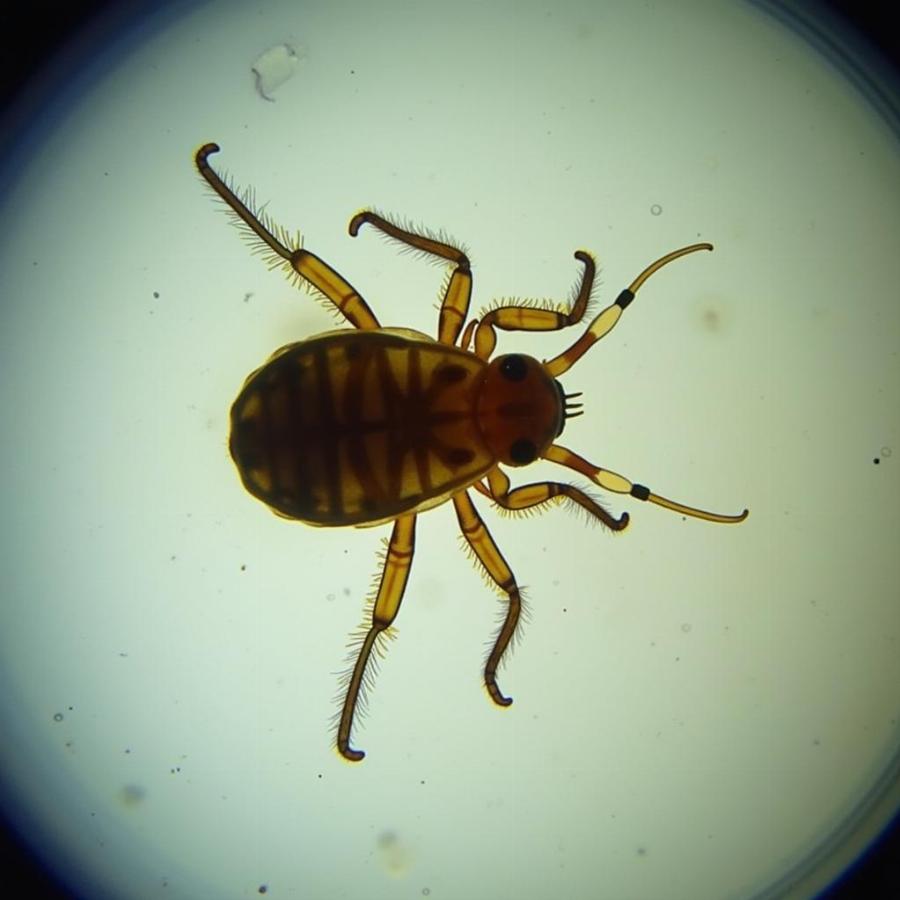Dog owners often worry about their furry companions bringing unwanted pests into their homes. Fleas and ticks are well-known culprits, but what about lice? Can dogs transmit lice to humans?
The good news is that dog lice are species-specific, meaning they can only live on dogs. Dog lice cannot survive on humans, and human lice cannot survive on dogs. So, while you might need to treat your canine friend for lice, you won’t have to worry about getting infested yourself.
Understanding Dog Lice
Dog lice are tiny, wingless insects that live on the skin and hair of dogs. They feed on skin debris and blood, causing itching and irritation. There are two types of lice that can infest dogs:
- Biting lice: These lice have mouthparts designed for chewing and primarily feed on skin debris.
- Sucking lice: These lice have piercing mouthparts that allow them to feed on blood.
 Dog Lice Under Microscope
Dog Lice Under Microscope
Both types of lice can cause discomfort for your dog.
Signs Your Dog Might Have Lice
Lice infestations are more common in dogs living in crowded or unsanitary conditions. Here are some common signs your dog might have lice:
- Excessive scratching and biting: Lice cause intense itching, leading to excessive scratching, biting, and licking.
- Restlessness: The discomfort caused by lice can make dogs restless and agitated.
- Visible lice or eggs (nits): Lice are small but can sometimes be seen with the naked eye, especially in areas with less fur. Nits, which are lice eggs, appear as small, white or yellowish dots attached to the hair shaft.
Treating Lice in Dogs
If you suspect your dog has lice, consult your veterinarian. They can confirm the diagnosis and recommend the most appropriate treatment, which may include:
- Topical medications: Shampoos, sprays, and spot-on treatments containing insecticides can effectively kill lice and their eggs.
- Oral medications: In some cases, your vet may prescribe oral medications to eliminate lice.
- Environmental control: Thoroughly clean and disinfect your dog’s bedding, toys, and any other areas where they spend time.
It’s important to follow your veterinarian’s instructions carefully and complete the entire treatment course to prevent reinfestation.
Preventing Lice in Dogs
Prevention is always better than cure when it comes to parasites like lice. Here are some tips to prevent lice infestations:
- Regular grooming: Brush your dog regularly to remove loose hair and debris that can harbor lice.
- Avoid contact with infested animals: Keep your dog away from dogs that are known to have lice.
- Maintain a clean environment: Regularly clean and disinfect your dog’s living areas.
Can Dogs and Cats Get Head Lice?
While we’ve established that dog lice can’t live on humans, you might wonder about transmission between dogs and cats. Just like with humans, dog lice cannot live on cats, and cat lice cannot live on dogs. Each species has its own type of louse that is specifically adapted to its fur and skin.
Keep Your Furry Friends Happy and Healthy
By understanding the types of parasites that can affect dogs and taking preventive measures, you can help keep your furry companions happy, healthy, and pest-free. Remember, regular veterinary checkups and prompt treatment are crucial for managing any parasite infestations.
For more information on dog health and care, visit Beaut Dogs.
If you need further assistance or have specific questions about your dog’s health, don’t hesitate to contact us at [email protected] for detailed and accurate answers.
Beaut Dogs is your one-stop resource for everything related to dog ownership, providing reliable, helpful, and in-depth information about the canine world. Here, you’ll discover a wealth of knowledge on the characteristics, personalities, and care requirements of various dog breeds, from the common to the rare and exotic.